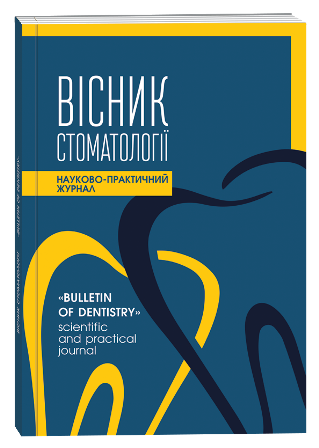MORPHO-FUNCTIONAL DISORDERS IN GUNSHOT LESIONS OF THE MAXILLOFACIAL REGION
DOI:
https://doi.org/10.35220/2078-8916-2024-52-2.20Keywords:
Morpho-functional disorders, bacteria, gunshot lesions, maxillofacial region.Abstract
In connection with the conduct of active military operations on the territory of Ukraine, the treatment of gunshot wounds is becoming increasingly relevant. Most often, during local military operations and anti-terrorist operations, gunshot wounds to soft tissues occur. Studies show that the frequency of gunshot wounds (GW) of the maxillofacial region in military conflicts of the last decade is 4.36-5.19 %. Injuries caused by modern firearms are characterized by multiple, combined and massive injuries. The most important features of Modern Combat surgical pathology are multiple and combined wounds, which in local conflicts ranged from 25 to 62 %. A gunshot wound should be considered as a serious violation of vital functions of the human body, which is directly dependent on the nature of the injuries received and on general regulatory disorders. It is generally accepted that wounds of any localization are accompanied by the risk of an infectious complication, and this primarily applies to gunshot wounds. The healing process is very complex. It can occur as a type of serous "traumatic edema", and healing will end with "primary tension". Possible complications in the form of suppuration of wounds, then healing goes by the type of "secondary tension". For the occurrence of a purulent process in the wound, it is necessary that the total number of microbes exceeds the "critical level", which varies significantly for various pathogens. For inflammation, it is usually enough that there are more than 10-1056 microbial bodies in 1 g of wound wall tissue. Fresh wound gunshot microflora is characterized by the following groups of pathogens. The first group includes sporogenic bacteria of fecal origin, tetanus bacilli and gas – forming anaerobes. These are typical representatives of primary microbial contamination. The second group includes non-sporeforming, mainly gram-negative bacteria such as Proteus, collie, Klebsiella, aerogenes and Pseudomonas. The third group consists of pyogenic cocci: Staphylococcus aureus, hemolytic streptococcus and anaerobic Streptococcus. They form both primary and secondary flora. The main pathogens are Staphylococcus aureus both in monoculture and in association with Escherichia coli, Proteus, and Staphylococcus epidermis. Recently, there has been an increase in the number of wounded people in whom the causative agents of Wound complications were not Staphylococcus monoculture, but microbial associations, as well as a clear increase in the specific weight of Gramnegative microflora.
References
Madsen A.S, Laing G.L., Bruce J.L., Clarke D.L. A comparative audit of gunshot wounds and stab wounds to the neck in a South African metropolitan trauma service. Ann R Coll Surg Engl. 2016. №98(7). Р. 488-495. doi:10.1308/rcsann.2016.0181.
McNickle A.G., Chestovich P.J., Fraser D.R. Cervical Spine Injury is Rare in Self-Inflicted Craniofacial Gunshot Wounds: An Institutional Review and Comparison to the US National Trauma Data Bank (NTDB). Prehosp Disaster Med. 2020. №35(5). Р. 524-527. doi:10.1017/S1049023X20000771.
Orthopoulos G., Sideris A., Velmahos E., Troulis M. Gunshot wounds to the face: emergency interventions and outcomes. World J Surg. 2013. №37(10). Р. 2348-2352. doi:10.1007/s00268-013-2139-x.
McLean J.N., Moore C.E., Yellin S.A. Gunshot wounds to the face--acute management. Facial Plast Surg. 2005. №21(3). Р. 191-198. doi:10.1055/s-2005-922859.
Reddy A., Bansal R., Kaloria N., Patel S., Gowda P.K. Utility of the Awake Video Laryngoscopy Assisted Fibreoptic Intubation Technique in Maxillofacial Gunshot Injury – A Case Report. Ann Maxillofac Surg. 2023. №13(1). Р. 120-122. doi:10.4103/ams.ams_31_23.
Oren, D., Dror, A.A., Zoabi, A. et al. The impact of delayed surgical intervention following high velocity maxillofacial injuries. Sci Rep. 2021. №11. Р. 1379. https://doi.org/10.1038/s41598-021-80973-7.
Thanneermalai B., Chattopadhyay P.K., Kamalpathey K., Semi R.S., Desai AP, Menon RP. Unusual Cause for Maxillofacial Injury. Ann Maxillofac Surg. 2018;8(1):166-170. doi:10.4103/ams.ams_173_17.
Breeze J., Tong D., Gibbons A. Contemporary management of maxillofacial ballistic trauma. Br J Oral Maxillofac Surg. 2017. №55(7). Р. 661-665. doi:10.1016/j.bjoms.2017.05.001.
Momeni Roochi M., Razmara F. Maxillofacial gunshot injures and their therapeutic challenges: Case series. Clin Case Rep. 2020. №8(6). Р. 1094-1100. Published 2020 Apr 13. doi:10.1002/ccr3.2827
Ke Y.K., Fang C.Y., Cheng Y.C., Hsu P.C. Management of maxillofacial gunshot injury with severe tissue avulsion. J Dent Sci. 2023. №18(1). Р. 482-483. doi:10.1016/j.jds.2022.07.019.
Hollier L.H. Jr., Sharabi S.E., Koshy J.C., Stal S. Facial trauma: general principles of management. J Craniofac Surg. 2010. №21(4). Р. 1051-1053. doi:10.1097/SCS.0b013e3181e5701c.
Khatib B., Gelesko S., Amundson M. et al. Updates in Management of Craniomaxillofacial Gunshot Wounds and Reconstruction of the Mandible. Facial Plast Surg Clin North Am. 2017. №25(4). Р. 563-576. doi:10.1016/j.fsc.2017.06.007.
Гуменюк К.В., Верба А.В.Досвід хірургічного лікування вогнепальних поранень та травм печінки в умовах 59 Військового мобільного госпіталю. Проблеми військової охорони здоров’я: Збірник наукових праць УВМА. 2016;46:278–283.
Гур’єв С.О., Кравцов Д.І., Казачков В.Є. Мінно-вибухова травма внаслідок сучасних бойових дій на прикладі антитерористичної операції на Сході України. Повідомлення 1. Клінікоепідеміологічна характеристика постраждалих із мінно-вибуховою травмою на ранньому госпітальному етапі надання медичної допомоги. Травма. 2015. №6(16). Р. 5-11.
Король С.О. Вогнепальні та мінно-вибухові поранення кінцівок в системі надання допомоги пораненим під час антитерористичної операції. Збірник наукових праць XVII з’їзду ортопедів-травматологів України. 2017;35-36(1-2):54-57.
Хоменко І.П., Король С.О., Шаповалов В.Ю., Хорошун Е.М.Організація надання хірургічної допомоги пораненим на рівнях медичного забезпечення при проведенні Антитерористичної операції/Операції об’єднаних сил. Військова медицина України.
№4(19). С. 5-15. doi: 10.32751/2663-0761-2019-04-01.
Непорожня В.М., Гулюк А.Г. Оцінка інформативності мікробіологічного дослідження біоптату з рани для прогнозування ускладнень загоєння ран при пошкодженнях м'яких тканин обличчя. Colloquiumjournal. 2021. №36(123). Р. 18-21.








